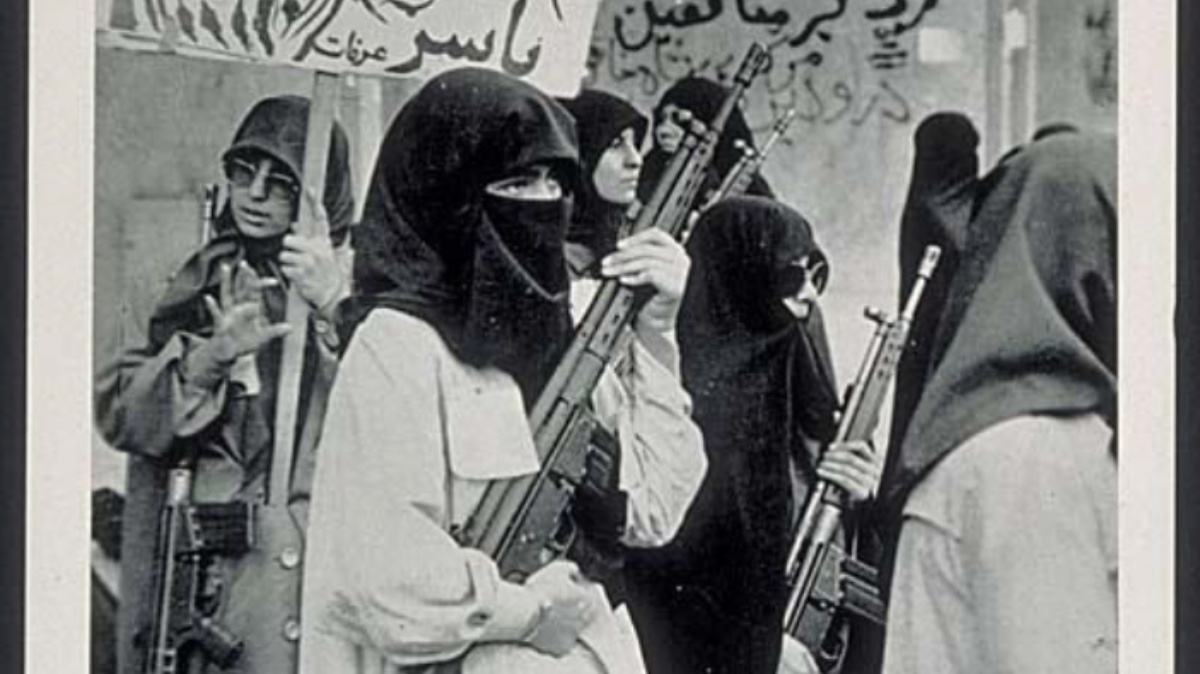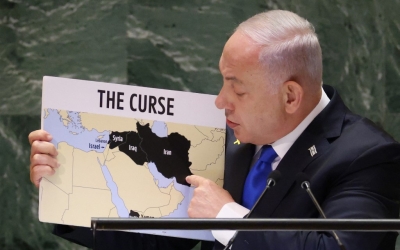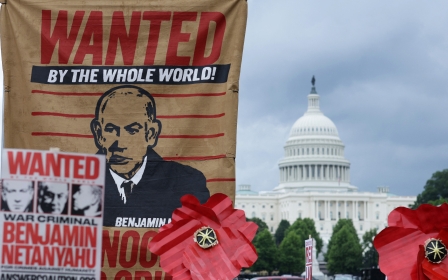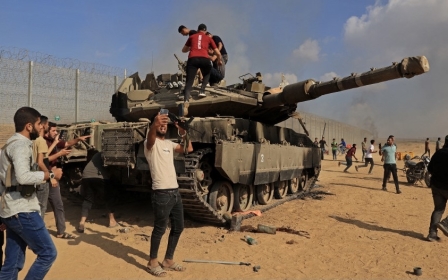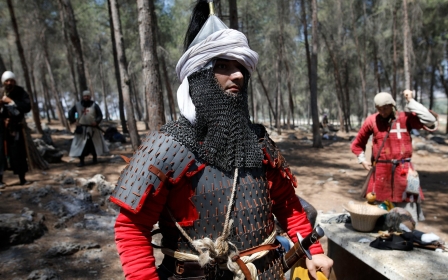
How the Axis of Resistance is shaping the Middle East
With Israel still in full assault on Gaza and Lebanon, the year-long multi-front war escalated sharply on 1 October 2024, when Iran launched a massive missile strike on military installations across Israel.
According to Tehran, this attack was a response to the Israeli assassinations of Iranian, Lebanese, and Palestinian figures, notably Hamas's political leader, Ismail Haniyeh, and Hezbollah's leader, Hassan Nasrallah.
This marked Iran's second direct strike on Israel in a conflict that pro-Israel pundits describe as a "six-front war", and the convergence of Middle Eastern conflicts into "one big war".
Since 7 October 2023, Israel has waged a war from Gaza and the West Bank to Lebanon, Syria, Yemen, Iraq, and Iran.
As early as 8 October, Hezbollah started a calculated military escalation against Israel, which was followed by attacks from Yemen, Iran, and Iraq under the banner of "unity of fields".
New MEE newsletter: Jerusalem Dispatch
Sign up to get the latest insights and analysis on Israel-Palestine, alongside Turkey Unpacked and other MEE newsletters
This month, Iran's major missile attack on Israel marked the height of coordinated operations. Abu Obaida, spokesperson for Hamas's military wing, the Izz al-Din al-Qassam Brigades, described the moment as the convergence of the ummah's flames of resistance in the skies of Palestine.
The Axis of Resistance, which centred Palestine as its ideological unifier, became an influential force in the region
This unprecedented mobilisation of multiple fronts in support of the Palestinian resistance has been a long time coming. It marked a culmination in the decades-long convergence of actors who together comprise the Axis of Resistance - a network of allied states and movements, including Iran, Syria, Hamas and the Islamic Jihad in Palestine, Hezbollah in Lebanon, Ansar Allah (also known as the Houthi movement) in Yemen, and various Iraqi forces.
Western policymakers and media dismiss the Axis of Resistance as a "terror network" with no history or context and frame it as an expansionist threat to stability in the Middle East.
Following the assassination of Sayyid Hassan Nasrallah on 28 September, US President Joe Biden praised Israel's air strike in Beirut's southern suburb, describing it as a strike against "the Iranian-supported terrorist groups" and their "reign of terror".
Israeli officials have called the axis an octopus: "Iran is the head of the octopus, and you see its tentacles all around from the Houthis to Hezbollah to Hamas."
After the Israeli defence minister called Palestinians human animals, New York Times columnist Thomas Friedman described the axis as an "invasive parasite". Taking the task of justifying the Israeli genocide to a new low, he wrote that Iran is a parasitoid wasp and the Houthis, Hezbollah, Hamas and Kataib Hezbollah are its eggs, concluding: "We have no counter-strategy that safely and efficiently kills the wasp without setting fire to the whole jungle."
Denying the humanity and the agency of these actors in the region (they are typically called proxies or tentacles) goes hand in hand with denying their resistance.
While the mainstream media frequently de-historicises and dehumanises the Axis of Resistance, its ideological roots emerged before the Iranian revolution in 1979. It has centred Palestine as its ideological unifier and evolved through a transnational circulation of people, ideas, and expertise, making the axis an influential force in the region.
Iranian revolution
Palestine had an indelible imprint on the 1978-79 revolution in Iran and its global vision. From the outset, when Ayatollah Khomeini staged a revolt from within the religious establishment, the Zionist colonisation of Palestine and Israel's ties with the shah, Mohammad Reza Pahlavi, were central to his revolutionary struggle.
In 1968, Khomeini issued a religious decree in support of the Palestinian fedayeen guerrilla forces, allowing his Shia Muslim followers to donate alms (zakat) to them. During the 1970s, Fatah, which was the dominant faction of the Palestine Liberation Organisation (PLO), emerged as a crucial node in the transnational anti-Shah movement.
It embraced the Iranian leftist and clerical revolutionaries and provided expertise, training, and connections with liberation fighters from around the globe.
Under the leadership of experienced commanders such as Yasser Arafat and Khalil al-Wazir, Fatah stood at the apex of the PLO for its strong leadership, resources, skilled cadres, and its all-encompassing ideology.
PLO leaders and roving Iranian revolutionaries were brothers in arms in the 1970s. Following the 1979 revolution, the PLO played an essential role in the establishment of the Islamic Revolutionary Guard Corps (IRGC), and the liberation of Palestine inspired its global vision.
Many co-founders of the IRGC - among them Mohammad Montazeri and Abbas Aqa-Zamani - received training in the Palestinian refugee camps in the 1970s.
They drew on the military training, expertise, and global ties they inherited from Fatah to build up the military arm of the revolution. Palestine was also central to the revolution's global vision, which was influenced by anti-colonial pan-Islamism and Third Worldist solidarity.
Religious revolutionaries in Iran were influenced by pan-Islamists, like Sayyid Jamaluddin al-Afghani and Hasan al-Banna, and advocated the unification of Muslims against imperialism.
Palestine, as an Islamic ecumenical cause, was at the heart of the unification to which revolutionary clerics aspired.
The 1978-79 revolution was also imbued with Third World solidarity. The Iranian revolutionaries found lessons and rejoiced in the struggles of Ahmed Ben Bella of Algeria, Patrice Lumumba of the Congo, and Gamal Abdel Nasser of Egypt against colonialism and neocolonialism.
Palestine was at the intersection of these liberation struggles and the ecumenical vision of clerical revolutionaries. To them, it was a struggle at the core of the conflict between Islam and global arrogance (Istikbar-i Jahani/al-sticker al-ʿalami, or imperialism).
Creation of the Axis
The Axis of Resistance emerged after 1979 during several crucial events, chief among them the 1978-79 revolution in Iran, the 1980 invasion of Iran by Iraq, and the 1982 invasion of Lebanon by Israel.
Iraq, under President Saddam Hussein, was fearful of the spread of the Iranian revolution, and Israel was concerned with an emerging PLO-Iran axis in Lebanon.
These invasions, which sought to contain the revolution within Iran's borders, instead drew Iran to Syria, seeding the Axis of Resistance. Thus, unlike the prevailing narratives in western media that describe the axis as expansionist, it originated as a defensive partnership between Iran and Syria.
At the time, Iran and Syria shared geopolitical concerns regarding Saddam's ambitions in the region. They feared the fall of Lebanon to the camp of Arab regimes like Jordan and Egypt, which had recognised Israel.
Between these two factors, Israel emerged as the enduring influence in consolidating the Iranian-Syrian alliance.
In June 1982, Israel launched an invasion of Lebanon, resulting in massive destruction and massacres, during which close to 50,000 Lebanese and Palestinians were killed.
The invasion managed to push the PLO from Lebanon, only to have it replaced with a mightier armed resistance. This marked the rise of the Islamic resistance in both the Lebanese and Palestinian spheres.
Hezbollah emerged from the Lebanese and Palestinian resistance to the Israeli invasion and managed to push out the Israeli army from Beirut and most of Lebanon's territory to southern Lebanon by 1985.
The cooperation between Iran and Syria, by providing bases, military training and arms, was crucial in Hezbollah's success against the Israeli army, which led to the withdrawal of Israel from Lebanon in 2000, excluding Shebaa Farms.
These achievements climaxed in July 2006, when Israel launched an all-out attack on Lebanon after Hezbollah's fighters captured Israeli soldiers in a cross-border raid, in order to exchange them for Lebanese prisoners in Israel.
Israel unleashed its military on Lebanon, declaring that the war would not stop until it crushed Hezbollah. Thirty-three days later, Israel agreed to a ceasefire without achieving any of its goals: no soldiers were returned, and Hezbollah emerged from the war both militarily and politically stronger.
These achievements solidified Hezbollah's image as the only armed resistance organisation to have forced Israel to surrender occupied territories. Indeed, Hezbollah obliterated Israel's long-standing red line: no compromise in the face of the armed resistance.
The PLO was influential in Hezbollah's formation. Besides the galvanising impact of the Palestinian struggle on the founders of Hezbollah, some of its key leaders, like Imad Mughniyeh or Abu Hassan Salameh, were originally members of Fatah.
Salameh, a native of Jabal Amil in southern Lebanon, exemplified Fatah's initial influence on Hezbollah, including the party's steadfast commitment to Palestinian armed resistance. He was so popular among Palestinians that Arafat gave him the nickname of the fallen Palestinian commander, Ali Hassan Salameh, who was assassinated by Mossad in 1979.
As a commander of Hezbollah from 1982 until his assassination by Israel in 1999, Abu Hassan Salameh orchestrated resistance in the south and provided extensive support to the PLO, Hamas, and Islamic Jihad.
Palestinian resistance
The transformation of the Palestinian resistance, led by Hamas and Islamic Jihad, has been notably shaped by the Islamic resistance in Lebanon.
The historic humiliation of Israel in 2000 was a galvanising moment for Palestinians, who had long been disillusioned with the Oslo Accords. The Second Intifada (2000-2005) flared up against this backdrop, with a resurgence of armed resistance against the Zionists. Hamas and Islamic Jihad persisted in building up their military capabilities, especially in the liberated Gaza.
Israel's 2005 disengagement from Gaza was a pivotal moment in the trajectory of the Palestinian resistance, not only for Gaza but also for advancing the broader goal of Palestinian liberation from the river to the sea.
Through collaboration with the Axis, the Izz al-Din al-Qassam Brigades, the military wing of Hamas and al-Quds Brigades, the armed wing of the Islamic Jihad, have steadily developed their military capabilities and expertise, posing a substantial challenge to the Israeli army.
From a reliance on machine guns at the time of Israeli withdrawal from Gaza, their arsenal has evolved to include missile technology capable of striking Tel Aviv and beyond with significant destructive force. Upgrading such military capabilities stemmed from long cooperation with Iran, Syria, and Hezbollah, which shared expertise in the development of missiles and drones with Hamas and Islamic Jihad.
This capability was demonstrated in different battles, notably during the 11-day Sword of Jerusalem battle of 2021, revealing the resistance's capacity to confront and disrupt Israel across its territory effectively.
Since 2000, the Axis of Resistance has unfurled in the crucible of wars and conflicts across the region. The US invasion of Iraq in 2003 and the Islamic State invasion in 2014 have brought several Iraqi militant groups into the Axis.
In the aftermath of the 2011-2012 Yemen Revolution, Ansar Allah has firmly sided with the Axis, developing bonds with Hezbollah, Hamas, and the IRGC.
Yet, Palestine, in the intersection of Islamic ecumenicalism and the Third Worldist liberation, has remained a unifying factor among the Axis's diverse actors who pursue their ideological and political agenda in various national contexts, sometimes in conflicting ways.
Tensions and conflicts
Far from being celebratory, the Axis's history has been marked by many tensions and conflicts over inter-Arab politics and the diverging pan-Arab, leftist, and Islamist leanings of its partners.
At fraught junctures, Iran, Syria, Hezbollah and Hamas diverged and even collided, sparking rumours and speculations about the imminent demise of their partnerships.
During the formative years of Syrian-Iranian relations in the 1980s, disagreements surfaced between Syrian President Hafez al-Assad and Khomeini over a range of issues, including the Iranian link with Arafat and the Islamic opposition in Syria, over Hezbollah and Amal in Lebanon, and the Iran-Iraq war.
Follow Middle East Eye's live coverage of the Israel-Palestine war
The revolutionary clerics in Iran sympathised with the Muslim Brotherhood and maintained ties with a faction of the Syrian Brotherhood, which worried Assad. While Iran's relationship with the Syrian Muslim Brotherhood remained limited, the clergy's support for Lebanese Sunni movements and Hezbollah led to major tensions between Damascus and Tehran in Lebanon.
Assad was initially distrustful of Hezbollah and feared it would strengthen the Muslim Brotherhood in Syria and back his archfoe, Arafat. Assad was also wary of an Iranian influence in Lebanon, which he saw as Syria's backyard.
Throughout the 1980s, differences and disagreements between Damascus and Tehran put Hezbollah on a collision course with Syria and led to a massacre of 28 Hezbollah members by the Syrian army in 1987.
At the same time, there was also a rivalry and conflict between Hezbollah and the pro-Syrian Amal, as the latter feared losing ground within the Shia community to the former. The Hezbollah-Amal conflict, which became known as the War of Brothers, lasted throughout the late 1980s until Syria and Iran sponsored an agreement between the two Lebanese groups in 1990.
Hezbollah recognised Syria's paramount role in Lebanon, which allowed it to protect its arms and ties to Iran.
As Tehran and Damascus consolidated their partnership in the 1990s, Iran's support for Palestinian and Lebanese resistance forces became increasingly linked to its alliance with Syria. Thus, it took a decade before Tehran and Damascus reached a modus vivendi, defying many expectations about the collapse of the partnership.
However, in the wake of the 2003 US invasion and overthrow of Saddam Hussein in Iraq, tensions began to surface between Tehran and Damascus over their differing visions for a post-Saddam political order.
Syrians wanted a role for the former ruling Baath Party, while Iran actively undermined it. A common enemy was gone, giving rise to speculations about the possible demise of this partnership. Still, the partnership endured, managing to exceed expectations.
Crisis and uprisings
With the post-2010 Arab uprisings, the Axis of Resistance faced one of its most challenging crises when anti-regime protests swept Syria, and the country took a dark turn into civil war.
The crackdown against protesters and political dissidents in Syria and the subsequent role of Iran undermined the legitimacy of both regimes. Iran has also suppressed numerous activists and protesters in recent years.
In early 2012, Hamas quietly abandoned its base in Syria, revealing fault lines within the Axis over Syria
As the protests in Syria militarised and developed into a war with an array of regional and international players, Hezbollah, in early 2013, began deepening its involvement in the war.
Hezbollah faced a mounting backlash both inside Lebanon and across the region for neglecting its resistance role against Israel and entering the civil war in Syria.
In early 2012, Hamas quietly abandoned its base in Syria, revealing fault lines within the Axis over Syria.
In the eyes of Assad, Hamas betrayed him and sided with his archenemy, the Muslim Brotherhood. In a moment of divide across the region, which appeared to be sectarian, losing Hamas posed a significant setback for the Axis. Yet Hamas's relationship with Iran and Hezbollah did not break.
Even the military wing of the movement, the Qassam Brigades, continued to build up its capabilities through working with the IRGC's Quds Force and Hezbollah.
In a few years, the mediation role of the former IRGC's Quds Force leader Qasem Soleimani and Hezbollah's Nasrallah revived the relationship between Syria and Hamas, culminating in a Hamas leadership visit to Damascus in 2022.
These efforts unfolded as the US, under both Trump and Biden, vigorously pursued the Abraham Accords to create a new Middle East centred on normalisation with Israel. It replaced the so-called Israeli peace with Palestinians with an Israeli normalisation with the autocrats in the region, chief among them the ruling families in Saudi Arabia, Bahrain, and UAE.
However, Hamas's actions on 7 October not only derailed the Abraham Accords but also revived the Axis of Resistance.
Even with the assassination of Hezbollah's leader in September 2024, unravelling the Axis remains a remote possibility.
Israeli Prime Minister Benjamin Netanyahu's wish for a new Middle East and the revival of the Abraham Accords will need much more than air strikes, intelligence sabotage, and assassinations of resistance leaders.
'Global Palestine'
For four decades, the Axis has evolved into a significant force shaping the political landscape of the Middle East. How has the Axis survived its many contradictions and paradoxes in a volatile region which has historically seen many short-lived alliances?
Israel's swift wars, fought with minimal losses on the lands of others and resulting in decisive victories, are a vestige of a bygone era.
What can explain the realignment of Hamas within the Axis, which, to the surprise of many observers, has derailed yet another US grand vision for the Middle East?
After all, to Zionists, the alliance between Arabs, Iranians, Sunnis, and the Shia is "unnatural", and according to their sectarian views of Middle Eastern societies and politics, it should have crumbled long ago.
It would have been difficult to imagine this longevity without the global pro-Palestine movement and the cause of liberating al-Quds, a rallying point for the ummah (the Muslim community).
In the words of the Islamic Jihad founder Fathi al-Shiqaqi: "Palestine and the unification…constitute the two sides of the Islamic agenda" in the face of "fragmentation [al-tajz'ia] and the Zionist entity; the two sides of the colonial scheme."
Beyond being a cause for Muslims, Palestine remains a quintessential Third World issue. Its connection with broader struggles for social, economic, and environmental justice continues to be one of the most unifying issues within the diverse global justice movement.
Radiating both Third Worldist solidarity and Islamic ecumenicalism, the heroes and martyrs of Palestine have unified the elements of the Axis beyond sectarian identities and political disagreements.
Since the early 1980s, the Axis's growth has notably changed the power dynamics between it and Israel.
There was a time when Israel deemed going to war a "luxury with minimal losses".
In the days leading up to the 1982 invasion of Lebanon, then chief of staff of the Israeli forces, Raphael Eitan, bragged that Israel has "got a well-oiled, well-prepared military machine. Why not use it then?"
As the Israeli army advanced into Beirut, some Lebanese and Palestinian fighters buried their arms and fled.
After the 2000 liberation of Lebanon, Nasrallah recalled the story of those fighters, proclaiming that "some buried their weapons in the dirt in 1982 when the Zionist army entered Lebanon. We will bury the Israelis should they return to our land again'.
Israel's swift wars, fought with minimal losses on the lands of others and resulting in decisive victories, are a vestige of a bygone era. This change owes much to the four decades of transsectarian and transnational solidarity and cooperation between the partners of the Axis of Resistance.
The views expressed in this article belong to the author and do not necessarily reflect the editorial policy of Middle East Eye.
Middle East Eye delivers independent and unrivalled coverage and analysis of the Middle East, North Africa and beyond. To learn more about republishing this content and the associated fees, please fill out this form. More about MEE can be found here.


